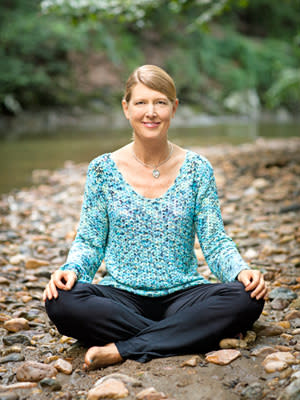Healing Soldiers Through Meditation

By Lisa M. Gerry
When students first arrive at Robin Carnes's meditation class at Walter Reed National Military Medical Center in Bethesda, MD, they often say, "This is never going to work for me." Indeed, you might not expect to see active duty military personnel, all just back from fighting overseas, in a meditation workshop.
Robin makes quick work of their skepticism. She dims the lights and encourages the participants-many suffering from post-traumatic stress disorder (PTSD), a sometimes debilitating anxiety condition that flares up long after a traumatic event is over-to lie down in recliners and close their eyes. (Students use the chairs instead of yoga mats to help alleviate any pain from combat injuries.) Robin then begins to lead the group through a guided meditation focused on breathing, body awareness and visualization. "Count each breath backward from 10," she says. "Notice the weight of your hands."
The goal is to teach students-some of whom experience flashbacks and nightmares as part of their PTSD-how to train themselves to have better control over their actions when they have strong emotions and thoughts, and to dial back their feelings of panic and anxiety. One of Robin's students stood guard on a base in Iraq for 18 months. Though he had been home in the States for more than a year, he felt as if he were still on watch: Hypervigilant, he jumped at every little sound and constantly looked for threats over his shoulder. "At the end of class during the second week, he got up, stretched and came over to me beaming," she recalls. "He said, 'I'm finally off duty. I feel great!'"
Related: Try these easy exercise drills to slim down fast.
The class is part of a three-week intensive outpatient program. "The majority of students have experienced multiple deployments, some up to 10 times," says Robin, a certified yoga and meditation teacher who also teaches at a studio in Takoma Park, MD. About 30% of men and women who have recently spent time in war zones experience PTSD, according to the National Institutes of Health.
Robin, 55, began working with the military in 2006 when she was asked to teach a class at Walter Reed. Part of the reason she said yes was that she knew firsthand how difficult PTSD is to work through. "I grew up in a strict religious family, but my parents went through a rocky time in their marriage when I was 13," says Robin. "I began to act out because my whole world was shattered. I had a baby when I was 15 and ran away from home for 10 months with the father of my child, who was a drug addict."
After living in dangerous situations for a year, Robin's family found her and they began the healing process, which included years of therapy and counseling. Though she was never diagnosed, Robin believes the experience triggered PTSD. Yoga, she says, helped her deal with the trauma, and in her 30s she began teaching. But after eight years of leading multiple classes per day, Robin cut back due to the stress it was putting on her body.
Around this same time, a friend introduced her to yoga nidra, which requires no physical poses. Practitioners instead focus the mind on the body to become aware of sensations and feelings through guided meditation. "Ifelt the same stillness and sense of calm that I experienced with yoga, but without the physical effort," says Robin, who decided to become certified in yoga nidra.
Related: Check out 10 yoga poses that will improve your sex life.
Robin had a feeling this type of meditation would be perfect for the class at Walter Reed. "I figured that if I could give even a small sense of that peaceful feeling to servicemen and -women, I would make a difference in their lives," she says. The class garnered positive feedback, and Walter Reed launched a study to explore the benefits of yoga nidra for those with PTSD. Before it began, Robin and a clinical psychologist adapted the practice to appeal to a mainstream audience and called the new version iRest meditation.
As Robin hoped, the research found evidence that iRest improved sleep, decreased anxiety, lessened chronic pain and helped PTSD sufferers manage emotions. When word spread about the study, Robin teamed up with a doctor and a clinical social worker to create Warriors At Ease (WarriorsAtEase.com), a yoga and meditation teacher certification course for those who want to teach military members.
Related: Bust stress with these 8 calming foods.
"I know now that this is what I was born to do," says Robin, who is concentrating on the WAE course and working to make sure soldiers have access to yoga and meditation classes. "There's an openness and a peace in the room, and we all walk out better able to handle the challenges of everyday life."
Where to Find Help for PTSD
If you (or a loved one) are in the military...Visit PTSD.va.gov to locate a PTSD treatment program near you. Or, call the Veterans Crisis Line at 800-273-8255 and press 1.
If you're a civilian...Find a therapist near you with a specialty in trauma/PTSD at Locator.apa.org.
Original article appeared on WomansDay.com.
You Might Also Like:
9 Innovative Kitchen Accessories
The Best Body Language for Any Situation
9 Ways to Initiate Sex
Become a fan of Woman's Day on Facebook and Twitter.
